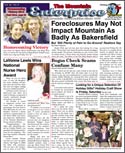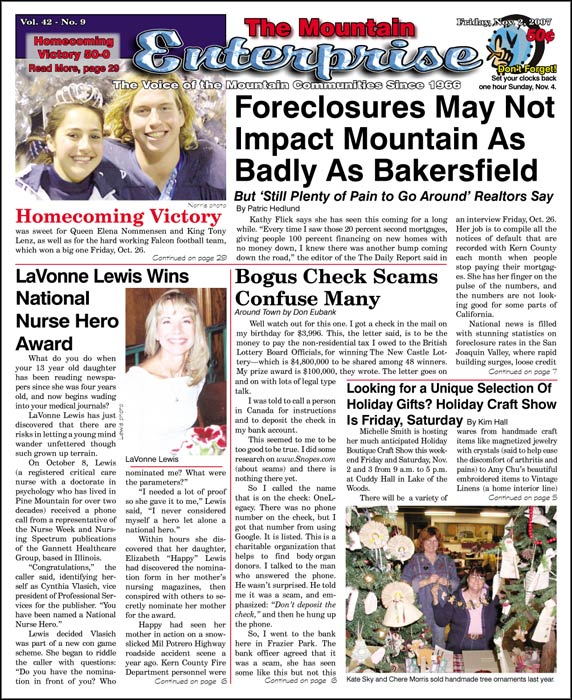But ‘Still Plenty of Pain to Go Around’ Realtors Say
By Patric Hedlund
Kathy Flick says she has seen this coming for a long while. "Every time I saw those 20 percent second mortgages, giving people 100 percent financing on new homes with no money down, I knew there was another bump coming down the road," the editor of the The Daily Report said in an interview Friday, Oct. 26. Her job is to compile all the notices of default that are recorded with Kern County each month when people stop paying their mortgages. She has her finger on the pulse of the numbers, and the numbers are not looking good for some parts of California.
National news is filled with stunning statistics on foreclosure rates in the San Joaquin Valley, where rapid building surges, loose credit standards and aggressive marketing tactics may have created the perfect storm for an imploding realty market. But are the Mountain Communties likely to be pulled under as well?
Flick predicts the rate of foreclosures in the Mountain Communities is apt to be far lower than that occurring in Bakersfield because there were not "overnight subdivisions" being built here.
"Its extremely bad right now," Flick said. "We are running 50 defaults per day. There are 500 defaults a week since last December. It just keeps going on and on and on. Most of it I truly believe were the loan products that asked for nothing down and now they have gigantic payments they have to come up with….I don’t think the Frazier Mountain area got caught up in this thing."
The avalanche of defaults she is seeing "are from these big tracts where people moved in with the 100 percent loans that were the rage in Bakersfield over the last few years."
Local realtors may disagree.
"Our rate may be far lower than Bakersfield, but it is much higher than any of the years I have been selling up here since 1991," commented Gary Wilson of Mountain Properties. "I guess you could say ‘on aggregate’ that their pain is more than ours, but we have lots of pain to go around."
Jeff Mowry of Jennings Realty said, "We saw the 100 percent loans here as did every community. They were the rage up here also."
There have been 131 Notices of Default from the first of 2007 to the end of October in the Frazier Park, Lebec, Pine Mountain area. Of those, 51 progressed from default to trustee sales, Flick reports.
Mowry points to loan investors who were competing for borrowers. "They loosened up the requirements—-those first-time home buyers with no down payment and FICO scores as low as 640 were getting financing."
He, too, has been watching loan scenarios carefully. He points to the $400,000 loan in which the seller pays three percent of the buyer’s closing costs and the buyer gets a 1.9 percent interest rate for the first year.
"After one year the loan rolls over to an adjustable rate. The borrower started off with a loan payment of $1,458.56. What a sweet deal. Then the year goes by and nothing has changed in their life— maybe their debt even went up—and the loan rolls over to 6 percent and now their payment is $2,398.20."
Another scenario he has seen is small investors purchasing a home with easy credit, but "when the market turned down and nobody is buying, the investment property you bought for profit" is suddenly a major liability as financing rates rise.
The National Association of Realtors this week said sales of existing homes are down eight percent. "A comparable [price] six months old may be obsolete in this market," one appraiser said.
Wilson reports the impact that foreclosures, have on the market.
"The bank wants to sell them as quickly as possible so they price them lower than similar homes, hoping to make a quick sale and decrease their personal inventory. Banks know that carrying houses on their books is not good business. There is no emotion in it from the bank and they have not even seen these homes. They are just files—assets to be sold in a timely manner… Some asset manager may have a thousand of these to sell around the country, so they have a system.
"They have an appraisal, look at market trends, and price accordingly. They don’t want to be overpriced in a declining market and follow the market down. They under price them right away. If they don’t sell in 30 days, they lower the price again and again and continue to do so until the property changes hands. That’s the system."
Mowry points out details of another confusion:
"The number of foreclosures is rising, but the numbers from Flick are hard to use. We try to negotiate with the lenders for ‘short pays.’ The lender is accepting less than the amount borrowed. Usually when we start, the lender is close to foreclosing. They file a Notice of Trustee’s Sale. As we are negotiating they keep filing the notice every month to protect their interest and then they waive the auction each month. I am working on one now and we were supposed to go to auction in April, so they have filed the Notice of Trustee’s Sale every month since April for one property. The buyers that get Notices of Default may pay up before they get to the Notice of Trustee’s Sale.
"My point is that the numbers [from Flick] can be influenced by many things. When our market crashed in the early 1990s we did not have an opportunity to negotiate short sales because the lenders lost more than 20 percent in value and took advantage of their mortgage insurance. Therefore your number of Notices of Trustee’s Sales was more accurate then.
"The better number to use would be actual foreclosures or actual short sales. Last week I saw in a newsstand in Ventura, front cover, bold type: ‘Housing Market Crashes, Values Drop 45.5%.’ I’d like to know how many home sales were used for that number."
Mowry added that prices for homes in Pine Mountain fell an average 8.9% since the last quarter of 2006. The good news, he adds, is that the "affordability index for first time home buyers in California at the end of the fourth quarter of 2006 was 14 percent; at the end of the second quarter of 2007 it is 24 percent, according to the California Association of Realtors.
"The demand for housing in California is high. Unemployment is low. The economy is strong. Inflation is low. I think we are in for a mild adjustment," Mowry concludes.
There are currently 152 homes for sale in Pine Mountain, "and this number hasn’t changed much throughout 2007. In the last 10 years I have seen that number as high as 280 and as low as 30," Mowry said. There are about 250 homes on the market as of this week in the mountain region as a whole.
This is part of the November 02, 2007 online edition of The Mountain Enterprise.
Have an opinion on this matter? We'd like to hear from you.


